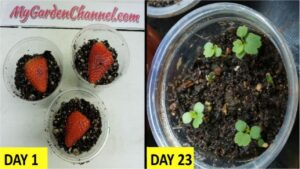Introduction
Growing Dogwood Ivory Halo cuttings is an excellent way to propagate new plants from an existing one. This process allows you to expand your garden or share the beauty of this stunning plant with others. In this step-by-step guide, we will walk you through the process of successfully growing Dogwood Ivory Halo cuttings.
The Soil Way
Step 1: Selecting and Preparing the Cuttings
1. In early spring, select healthy stems from the Dogwood Ivory Halo plant that are approximately 6-8 inches long.
2. Using clean pruning shears, make a clean, angled cut just below a leaf node. This will provide a suitable area for new roots to develop.
Step 2: Preparing the Cuttings for Rooting
1. Remove any leaves from the lower 2/3 of the cutting. This will prevent excessive moisture loss during the rooting process.
2. Dip the cut end of the stem into rooting hormone. This will promote root development and increase the chances of successful rooting.
Step 3: Planting the Cuttings
1. Fill small pots or containers with a well-draining potting soil mixture.
2. Create a small hole in the soil using a clean, sharp knife or your finger.
3. Place the treated end of the cutting into the hole, ensuring that at least 2 leaf nodes are buried in the soil.
4. Gently press the soil around the cutting to secure it in place.
Step 4: Providing Optimal Conditions for Rooting
1. Water the newly planted cuttings thoroughly, ensuring that the soil is evenly moist but not waterlogged.
2. Cover the pots or containers with a plastic bag or propagator to create a greenhouse-like environment. This will help retain moisture and humidity necessary for root development.
3. Place the cuttings in a warm location with indirect sunlight. Avoid exposing them to direct sunlight, as it may lead to excessive drying.
Step 5: Caring for the Cuttings
1. Check the cuttings regularly and mist them with water if the soil appears dry.
2. Remove any leaves that show signs of decay or mold to prevent the spread of disease.
3. After 6-8 weeks, gently tug on the cuttings to check for resistance, indicating root development.
4. Once the cuttings have developed a healthy root system, carefully transplant them into larger pots or directly into the garden.
The Water Way
Step 1: Preparation
1. Select healthy dogwood ivory halo cuttings in early spring or late autumn when the plant is dormant.
2. Use sharp and clean pruning shears to take cuttings from the mother plant. Cut just below a leaf node, ensuring the cutting is around 6-8 inches long.
3. Remove any leaves from the lower portion of the cutting, leaving only a few leaves at the top. This will help reduce water loss and encourage root growth.
Step 2: Water Propagation
1. Fill a clean glass jar or vase with distilled water. Make sure there are no impurities or chemicals in the water that could harm the cuttings.
2. If desired, dip the cut end of the dogwood ivory halo cutting into rooting hormone to promote root development. Shake off any excess hormone before placing the cutting in water.
3. Place the cutting into the water, ensuring that at least two leaf nodes are submerged. The nodes are where the roots will emerge from.
4. Place the container in a location with bright, indirect sunlight or under grow lights. Avoid direct sunlight, as it may cause excessive heat and damage the cutting.
5. Cover the container with a plastic bag or plastic wrap to create a humid environment. This will help prevent moisture loss and encourage root growth.
Step 3: Care and Maintenance
1. Check the water level regularly and replenish it as needed to keep the nodes submerged. Change the water every 1-2 weeks to prevent the growth of algae or bacteria.
2. Monitor the cutting for signs of root development. After a few weeks, you should notice small white roots emerging from the nodes.
3. Once the roots have grown to around 1-2 inches long, you can transplant the cutting into a pot with well-draining soil. Use a container that is large enough to accommodate the roots.
4. Keep the newly potted cutting in a location with bright, indirect sunlight. Water it regularly and ensure the soil remains moist but not waterlogged.
5. After a few weeks, you can gradually acclimate the newly rooted cutting to outdoor conditions. Provide protection from harsh sunlight and extreme temperatures during this transition period.


